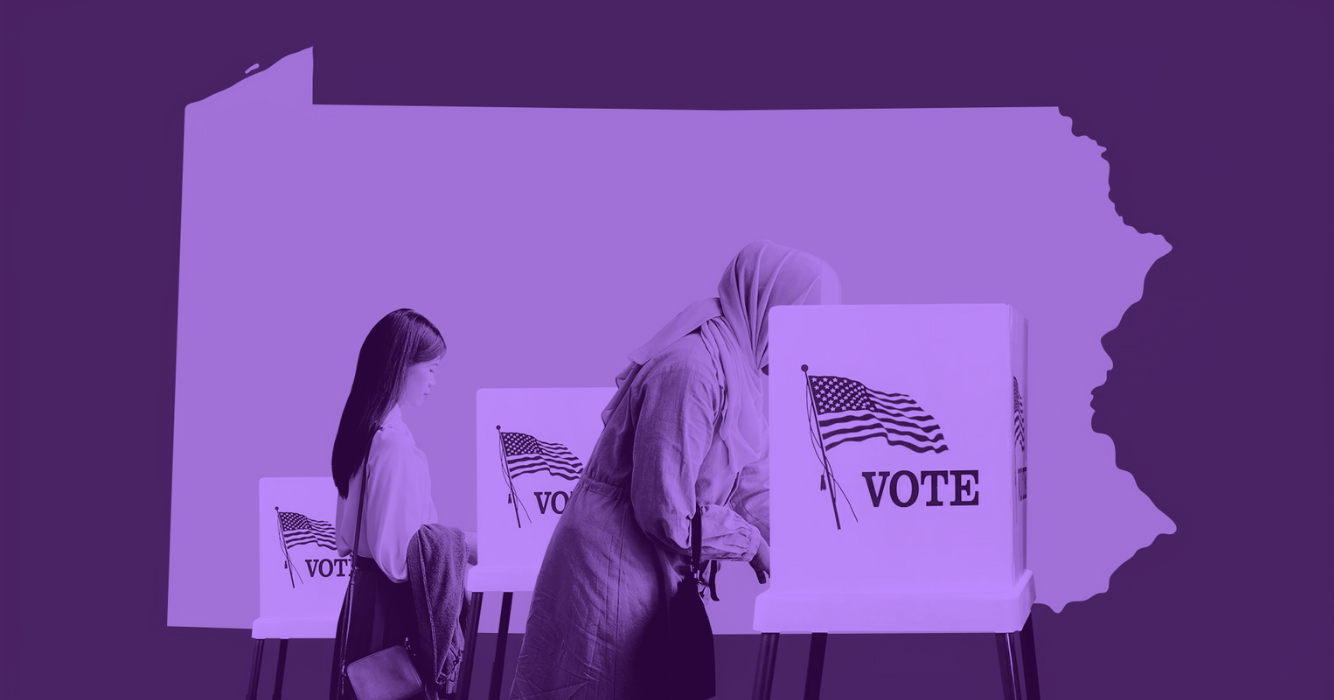Can Pennsylvania’s fast-growing Asian population help swing the state blue?

Among Asian Americans, Kamala Harris leads opponent Donald Trump by 33%. That advantage likely extends to crucial swing states like Pennsylvania, where voter turnout of this group could create a pathway to the White House.
Using data from the moveBuddha Moving Cost Calculator, we examined user searches for moves into and out of Pennsylvania since 2020. Our analysis shows that the Pennsylvania cities attracting more new residents than they lose to out-migration are also cities with some of the fastest-growing Asian American and Pacific Islander (AAPI) populations in the state.
Key Takeaways
- The Asian population in PA has increased 47% from 2010 to 2022. That’s a lot considering the state’s overall population has only increased 2.1% across that timespan.
- Over half of Pennsylvania’s top move-to cities since the last election saw their Asian population increase from 2020-2022. And most of them are in highly populated areas around predominantly blue-voting regions.
- Top inbound cities in blue-dominant counties have an average of 5.15% Asian residents, translating to nearly 50k potential votes. While red-dominant counties have only 1.59% Asian residents on average, representing a much smaller 2k potential votes.
Pennsylvania’s Asian American population is growing faster than its overall population
Population and voting data from the last election found that Trump-won counties have positive domestic migration while Biden-won counties are losing residents. But that doesn’t paint the entire picture, especially when we look closer at the state’s Asian American population. After all, Biden won the top move-to destinations for international migrants in Pennsylvania, including spots like Montgomery County outside Philadelphia.
Looking at Census data from 2010 to 2022, residents identifying as Asian have increased at much higher rates than the state’s population as a whole.
| 2010 | 2022 | % Change 2010-2022 | |
| PA Population | 12,711,406 | 12,972,008 | 2% |
| Asian Population | 354,384 | 519,968 | 47% |
And that’s just based on 2022 population estimates. More recent demographic data for 2024 finds that the AAPI (Asian American and Pacific Islander) population is as much as 612,567, with 333,590 of those eligible voters.
While AAPI Pennsylvanians only constitute 4% of the state’s population, the margins are so close in the 2024 presidential race that these votes will be critical. The Asian American voting demographic certainly was crucial in the 2020 election, with the number of ballots cast by AAPI voters increasing 47% from 2016 to 2020 (compared to just 12% for all other voters). Indeed, Joe Biden won Pennsylvania by less than 100,000 votes.
Pennsylvania’s Asian American voters will be especially powerful in larger cities that attract new residents. 22% of the state’s Asian population is in the Philadelphia area, including 2 of the most populous and popular in-move cities.
The result is that while Pennsylvania has been struggling to retain its population, the Asian American population is experiencing an influx. That could lead to demographic shifts that impact future elections.
Impact of a Growing Asian Population in Pennsylvania’s Top Cities to Move to
Out of 141 cities with positive inbound relocation since the last election, we collected Census data for 104. Of these, more than half (64) have seen an increase in Asian populations since 2010.
The top move-to cities with the highest proportion of Asian populations are:
| City, State | % Asian Population 2010 | % Asian Population 2020 | % Asian Population 2022 |
| Exton, Pennsylvania | 15.25% | 29.68% | 27.90% |
| Hatfield, Pennsylvania | 20.16% | 27.06% | 26.22% |
| King Of Prussia, Pennsylvania | 16.35% | 24.63% | 23.47% |
| Chadds Ford, Pennsylvania | 7.60% | 9.91% | 16.89% |
| Lansdale, Pennsylvania | 13.68% | 15.30% | 15.81% |
These Pennsylvania cities are among those that stand to win the most residents from relocation and are also locations with particularly high Asian populations.
This could contribute to a more substantial Democratic base in these areas. In a recent poll from The Pell Center, 57% of AAPI voters indicated that Harris was their presidential pick (Aug 2024).
Take Exton, a suburban town west of Philadelphia where almost 30% of residents are Asian American. With an in-to-out move ratio of 1.32, the influx of new residents stands to make a dent in the existing margins between registered Democrats and Republicans in Chester county. As of August 2024, registered Democrats numbered only about 7,000 more than Republicans.
Another Philly suburb, King of Prussia is currently 23.5% Asian American, with about three times the population of Exton. Yet another is Lansdale, a suburban town north of Philadelphia where Asians make up 16% of the local population.
As Philadelphia grows, it stands to reason that enclaves where cultural and linguistic networks blossom all around this urban oasis. New movers are attracted by the resources they find here — adding to the growing Asian American population and turning these counties even bluer.
How Asian American Population Growth in Pennsylvania’s Inbound Cities Could Swing the Election Blue
Given that Biden’s 2020 margin of victory in Pennsylvania was just around 80,000 votes in 2020, Asian Americans’ 300,000 votes in 2024 could determined whether Pennsylvania swings red or blue.
That’s a big change since recent elections. In fact, in just two years (2020 to 2022), the state’s Asian population grew by 24k, which suggests that the state’s AAPI population may have increased by as much as 48k in the 4 years since the 2016 presidential election.
Numeric increase in PA's Asian population:
- 2010-2022: ~140,000*
- 2020-2022 ~24,000*
*Based on Census Population Estimates
To further understand the impact of this growing demographic and the power of their votes in top cities for relocation, we compared Pennsylvania’s August 2024 county-level voter registration with the top move-to cities.
The result? The potential voting power of Asian Americans is significantly greater in cities with higher inflow within Democratic-leaning counties compared to those in Republican-dominated areas.
The cities located in Democratic-leaning counties saw the average proportion of their Asian American population increase from 3.92% in 2010 up to 5.15% in 2022. According to U.S. Census estimates, this amounts to a numeric increase of nearly 50,000.
Will PA’s AAPI Votes Turn the State Blue?
In a closely contested race, moves into and out of a state can have a huge impact. And data has shown that it’s Republican counties that are winning the most new moves.
In Pennsylvania, the same is true. Some of the biggest growth areas were in Republican suburban counties. But who is moving and how they will vote is much more nuanced.
As Pennsylvania’s urban centers grow alongside its Asian American population, these counties are more likely than ever to turn blue, with their overall larger numbers than those of other demographics.
The result is that smaller, more conservative cities don’t have the volume of incoming movers to keep up with the likes of Asian Americans in blue-leaning metro areas. We don’t know how these particular movers will vote, but if history is any guide, the keystone state will have to contend with a shifting tide of votes and voters this year and in upcoming elections.
Methodology
We collected mover search data using moveBuddha’s Moving Cost Calculator from November 4, 2020, to August 8, 2024. This data included searches for both inbound and outbound relocations. We identified 169 Pennsylvania cities with at least 25 searches for both moving into and out of the city.
Identifying the top move-to cities:
- To determine the most sought-after relocation cities, we calculated the in-to-out move ratio.
- Calculating the in-to-out move ratio: We took the number of searches for moves into a city and divided it by the number of searches for moves out of the city.
- A ratio greater than 1 indicates more searches for moving into the city than moving out.
Out of the 169 cities, 141 had an in-to-out move ratio greater than 1, indicating a net inflow of movers.
Demographic Analysis:
We analyzed U.S. Census demographic data for the years 2010, 2020, and 2022 to assess changes in the Asian populations across these top move-to cities.
Of the 141 cities with a favorable in-to-out ratio, we had sufficient demographic data for 104 cities. Among these, 64 cities showed an increase in their Asian populations.
Voter Registration Data:
We referenced county-level voter registration data from August 2024 provided by the Commonwealth of Pennsylvania to identify the dominant political party in each county.
This data helped us understand the potential political impact of the Asian population in these cities.
Not what you were looking for?
Check out other categories that can help you find the information you need!

